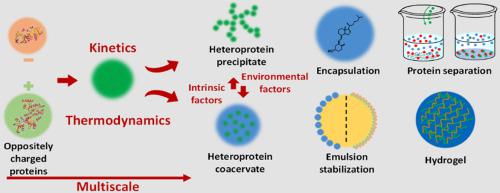Advances in Colloid and Interface Science ( IF 15.6 ) Pub Date : 2020-09-14 , DOI: 10.1016/j.cis.2020.102268 Jiabao Zheng 1 , Chuan-He Tang 2 , Weizheng Sun 2

|
Proteins are important components of foods, because they are one of the essential food groups, they have many functional properties that are very useful for modifying the physicochemical and textural properties of processed foods and possess many biological activities that are beneficial to human health. The process of heteroprotein complex coacervation (HPCC) combines two or more proteins through long-range coulombic interaction and specific short-range forces, creating a liquid-liquid colloid, with highly concentrated protein in the droplet phase and much more diluted-protein in the bulk phase. Coacervates possess novel, modifiable, physicochemical characteristics, and often exhibit the combined biological activities of the protein components, which makes them applicable to formulated foods and encapsulation carriers. This review discusses research progress in the field of HPCC in three parts: (1) the basic and innovative experimental methods and simulation tools for understanding the physicochemical behavior of these heteroprotein supramolecular architectures; (2) the influence of environmental factors (pH, mixing ratio, salts, temperature, and formation time) and intrinsic factors (protein modifications, metal-binding, charge anisotropy, and polypeptide designs) on HPCC; (3) the potential applications of HPCC materials, such as encapsulation of nutraceuticals, nanogels, emulsion stabilization, and protein separation. The wide diversity of possible combinations of proteins with different properties, endows HPCC materials with great potential for development into highly-innovation functional food ingredients.
中文翻译:

杂蛋白复合物凝聚:专注于研究结构形成作为食品应用中内在和外在的理化参数的函数的实验策略
蛋白质是食物的重要组成部分,因为它们是必不可少的食物类别之一,它们具有许多功能特性,这些特性对于改变加工食品的理化特性和质地特性非常有用,并且具有许多有益于人体健康的生物学活性。异蛋白复合凝聚(HPCC)的过程通过远程库仑相互作用和特定的短程作用力将两种或多种蛋白质结合在一起,形成液-液胶体,液滴相中的蛋白质高度浓缩,而在液滴相中的蛋白质稀释得多。本体相。凝聚层具有新颖,可修改的理化特性,并且经常表现出蛋白质组分的综合生物学活性,这使其可用于配制食品和包囊载体。本文从三个方面讨论了HPCC领域的研究进展:(1)基本的和创新的实验方法和模拟工具,用于了解这些杂蛋白超分子结构的理化行为;(2)环境因素(pH,混合比,盐,温度和形成时间)和内在因素(蛋白质修饰,金属结合,电荷各向异性和多肽设计)对HPCC的影响;(3)HPCC材料的潜在应用,例如营养药的封装,纳米凝胶,乳液稳定化和蛋白质分离。具有不同特性的蛋白质的可能组合的多样性使HPCC材料具有发展成为高度创新的功能性食品成分的巨大潜力。(1)用于理解这些杂蛋白超分子结构的物理化学行为的基础和创新实验方法和模拟工具;(2)环境因素(pH,混合比,盐,温度和形成时间)和内在因素(蛋白质修饰,金属结合,电荷各向异性和多肽设计)对HPCC的影响;(3)HPCC材料的潜在应用,例如营养药的封装,纳米凝胶,乳液稳定化和蛋白质分离。具有不同特性的蛋白质的可能组合的多样性使HPCC材料具有发展成为高度创新的功能性食品成分的巨大潜力。(1)用于理解这些杂蛋白超分子结构的物理化学行为的基础和创新实验方法和模拟工具;(2)环境因素(pH,混合比,盐,温度和形成时间)和内在因素(蛋白质修饰,金属结合,电荷各向异性和多肽设计)对HPCC的影响;(3)HPCC材料的潜在应用,例如营养药的封装,纳米凝胶,乳液稳定化和蛋白质分离。具有不同特性的蛋白质的可能组合的多样性使HPCC材料具有发展成为高度创新的功能性食品成分的巨大潜力。



























 京公网安备 11010802027423号
京公网安备 11010802027423号